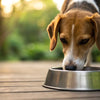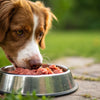How to Serve Raw Dog Food: A Comprehensive Guide for Pet Owners
- Houndsy
Table of Contents
- Introduction
- The Benefits of a Raw Diet
- How to Choose the Right Raw Dog Food
- Safe Handling Practices for Raw Dog Food
- Transitioning Your Dog to Raw Food
- How to Prepare and Serve Raw Dog Food
- Addressing Common Concerns and Myths About Raw Feeding
- Using the Houndsy Kibble Dispenser for Optimal Feeding
- Conclusion
Introduction
Have you ever stopped to consider what goes into your dog’s food? According to a survey conducted by the American Pet Products Association, over 70% of pet owners are increasingly conscious about the ingredients in their pet's meals. As devoted pet parents, we all want to provide the best for our furry companions, and many are turning to raw feeding as an option. But how do we navigate the raw dog food landscape? How do we ensure our beloved pets receive the nutrition they need while making the transition seamlessly?
In this blog post, we will delve into the ins and outs of serving raw dog food, addressing everything from the benefits to the safety measures and the practical steps you should take. By the end of this guide, you'll have a well-rounded understanding of how to serve raw dog food effectively.
We’ll cover the following aspects:
- The Benefits of a Raw Diet
- How to Choose the Right Raw Dog Food
- Safe Handling Practices for Raw Dog Food
- Transitioning Your Dog to Raw Food
- How to Prepare and Serve Raw Dog Food
- Addressing Common Concerns and Myths About Raw Feeding
- Using the Houndsy Kibble Dispenser for Optimal Feeding
Our mission at Houndsy is to simplify and enhance the feeding experience for pet owners like you, and we are here to support your journey towards more wholesome feeding practices.
The Benefits of a Raw Diet
Many pet owners are discovering that a raw diet provides numerous advantages, benefiting both the physical and mental well-being of our dogs. Here are some key benefits to consider:
Enhanced Nutritional Value
Raw dog food is often rich in vitamins and minerals, offering higher biological value compared to processed kibble. Raw meats, organs, and bones are packed with nutrients, providing essential proteins, healthy fats, and minerals that promote overall health. This might lead to improved coat condition, vitality, and even dental health in dogs.
Weight Management
Introducing a raw diet could potentially aid in weight management. Raw foods generally contain fewer carbohydrates, and less filler is used compared to traditional kibble, meaning our dogs might feel full sooner with fewer calories. Adjusting their diet can help maintain a healthy weight and body condition.
Healthier Digestion
A raw food diet can promote a healthier gut due to its higher moisture content and minimal processing. The natural enzymes present in raw food can support gut health and improve digestion. Owners often report reduced issues related to constipation or diarrhea when transitioning to a raw diet.
More Energy and Vitality
Switching to raw can yield higher energy levels in dogs. The easy digestibility and nutrient density keep our furry friends feeling spry and active, perfect for a day out in the park or a vigorous game of fetch.
How to Choose the Right Raw Dog Food
Navigating the world of commercial raw dog food may be overwhelming at first. Here are some steps to guide us in choosing the right option:
Assessing Ingredients
When selecting raw dog food, always review the ingredient list. Look for a high protein content derived from real meat, alongside organs and bone. Avoid products that list vague terms like "meat by-products" or fillers. The rule of thumb is to choose food with at least 80% meat, 10% bone, and 10% organ meat.
Consider Nutritional Balance
Seek out products that ensure a balanced diet. This means they should comply with regulations set forth by the Association of American Feed Control Officials (AAFCO). The label should indicate that the food is "complete and balanced" for your dog’s life stage.
Choose Quality Brands
Research the brand to ensure proper sourcing and production practices. Opting for companies that prioritize transparency, ethical sourcing, and have a good reputation can provide peace of mind. Brands that utilize high-quality, human-grade ingredients are typically considered reliable.
Variety in Proteins
Just like us, our dogs benefit from a variety of nutrients that can be found in different proteins. If your dog does not have specific sensitivities, consider rotating between different protein sources such as chicken, beef, turkey, lamb, and fish to maintain a well-rounded diet.
Safe Handling Practices for Raw Dog Food
Handling raw dog food may elicit some concerns due to bacteria; however, with proper practices, we can mitigate risks. Here are some recommendations:
Storage Guidelines
- Freezing: Keep raw dog food frozen until you are ready to serve it. This helps prevent the growth of harmful bacteria.
- Thawing: Always thaw dog food in the refrigerator or submerge it in cold water, rather than leaving it out at room temperature. The temperature danger zone for bacteria is between 40°F and 140°F.
Preparation Tips
- Utensils: Use separate utensils and cutting boards for preparing raw pet food, distinct from those used for human food, to avoid cross-contamination.
- Sanitation: Wash hands thoroughly with warm, soapy water after handling raw food, and sanitize all surfaces that come into contact with it.
Container Selection
Utilizing stainless steel bowls is highly recommended for serving raw dog food. They are easy to clean and ensure minimal bacterial growth.
Transitioning Your Dog to Raw Food
Making the switch from a regular diet to raw dog food requires care and consideration. Here’s a step-by-step approach:
Gradual Introduction
Start by replacing a small portion of your dog’s current diet with raw food. Slowly increase this portion over 1-2 weeks. This gradual transition allows your dog's digestive system to adapt without causing discomfort.
Monitoring Reactions
Pay close attention to how your dog reacts after eating raw food. Look out for any signs of digestive upset such as vomiting or diarrhea. If these symptoms arise, consider slowing the transition.
Supplement Support
Enzymes and probiotics, like raw goat milk or kefir, may help ease the transition. They can provide additional support for digestion and make the shift smoother for our furry friends.
How to Prepare and Serve Raw Dog Food
Once you’ve chosen a suitable raw dog food and ensured a smooth transition, it’s time to consider how to prepare and serve it effectively.
Simple Serving Steps
- Thaw: Take the desired amount from the freezer and thaw it in the fridge or under cold running water.
- Spoon and Serve: Using a stainless steel bowl, spoon the appropriate portion into the dish.
- Watch and Enjoy: Embrace the joy of watching your dog savor their meal!
Meal Timing and Routine
Establish a consistent feeding schedule that works for both you and your dog. Offering food at the same time every day may promote a sense of routine and security.
Addressing Common Concerns and Myths About Raw Feeding
Despite the growing acceptance of raw feeding, several misconceptions linger. Let’s address some of these.
Bacteria Concerns
Many worry about the implications of bacteria in raw dog food. While it is essential to practice safe handling, raw dog food can be handled safely with the same precautions we take when cooking for ourselves.
Nutritional Balance
Another common concern revolves around the nutritional balance of a raw diet. A well-thought-out raw feeding plan can provide the necessary balance of protein, fat, and essential vitamins and minerals.
Cost-Effectiveness
Some consider raw feeding too expensive; however, the actual costs may balance out when we factor in the potential savings from improved health, reduced vet visits, and good quality life for our pets.
Using the Houndsy Kibble Dispenser for Optimal Feeding
To elevate your pet feeding routine, consider how the Houndsy Kibble Dispenser can assist you. Our flagship product combines convenience and design excellence, making it ideal for raw and dry feeding alike.
Features
- Crank at Standing Height: With our ergonomic design, you can easily feed your dog without bending down, saving your back during mealtime.
- Perfect Portioning: Delivering consistent portions helps maintain your dog’s weight and health.
- Stylish Design: Its mid-century modern aesthetic ensures it complements your home decor while being functional.
By integrating the Houndsy Kibble Dispenser into your feeding routine, you'll be adding both elegance and ease, making this essential part of your pet care as enjoyable as it should be.
Conclusion
Feeding your dog a raw diet can be rewarding, both for you and your furry friend. By understanding the benefits, carefully selecting high-quality food, practicing safe handling, and establishing a solid routine, we can provide our dogs with the nourishment they deserve.
Although the world of raw dog food might seem daunting at first, armed with knowledge and resources, we can turn mealtime into an enriching experience for our pets. So as we embark on this journey, consider how the Houndsy Kibble Dispenser can play a role in simplifying your feeding process.
FAQ
How do I know if raw feeding is suitable for my dog?
Start with a gradual introduction, observing their reactions. If they respond positively, it is likely that a raw diet can be beneficial.
Can I mix raw food with commercial kibble?
While some pet owners do this, it may not be optimal as mixing can lead to digestive confusion. Always consult with your vet before making significant dietary changes.
Is it safe to store raw dog food in the refrigerator?
Yes, but ensure it is properly sealed and consumed within 2-3 days of thawing.
What are the signs my dog is adapting well to a raw diet?
Look for improved energy levels, a shiny coat, and stable digestive health as indicators your dog is thriving on a raw diet.
By understanding how to serve raw dog food effectively, we invest in the health and happiness of our beloved pets, making every meal a joyful experience.













